Your Call?
Which two of today’s seven featured images are you favorites? Please be so kind as to let us know why you made your choices.
What’s Up?
We’ve had two straight excellent mornings with the spoonbills on the Extended Stick Marsh IPT. On Friday, San Diego IPT veteran Colleen (Irish Lass) O’Connor joined multiple IPT vets Judy Stepenaskie, Vasili Chernishof, Anita North and me for a great morning session. I continued to experiment with the new Sony FE 400-800mm f/6.3-8 G OSS lens, learned a lot more, and made some very fine images.
I was glad to learn that Used Gear Page veteran Robert Hollyer sold his Sony FE 400mm f/2.8 GM OSS lens in Like-New condition for a BAA record low $8998.00! (was $9,998.00) I late March. BAA friend Kevin Hice purchased my last used Induro GIT 304 L by phone on Friday.
Today is Saturday 29 March 2025. The five of us will be up early to head over to Indian Lake Estates to check on the baby Sandhill Cranes and lots more. Whatever you plan on doing, I hope that you too opt to have a wonderful day. Do remember that happiness is a choice — Byron Katie, The Work.Com.
If an item — a Delkin flash card, or a tripod head — for example, that is available from B&H and/or Bedfords, is also available in the BAA Online Store, it would be great, and greatly appreciated, if you would opt to purchase from us. We will match any price. Please remember also to use my B&H affiliate links or to earn 3% cash back at Bedfords by using the BIRDSASART discount code at checkout for your major gear purchases. Doing either often earns you free guides and/or discounts. And always earns my great appreciation.
The Sony 400-800mm G Zoom Lens — Slow, a Bit on the Heavy Side: But With Spectacular Results!
I used the new 4-8 a good deal on both of our Stick Marsh mornings. After a while, I felt the weight. Sitting on a milk crate allowed me to support my left forearm and the weight of the lens in a rest position. Working in Manual mode, I needed to be at f/8 to avoid any exposure screw-ups. As there was a lot more sun on Thursday, I found the lens a lot more useful for flight than on Friday when we had some early clouds come in. It goes without saying, however, that the relatively low maximum aperture of f/8 is a handicap in cloudy conditions. But the images are the payoff.
Huge thanks to Anita North, Larry Master, and Pamela Viale who each used A BAA affiliate link to order their Sony FE 400-800mm f/6.3-8 G OSS lenses. Pam is pairing her 4-8 with her 300mm f/2.8 (plus both TCs); that seems like a perfect marriage to me. Each and them and everyone else who uses either my B&H link or the BIRDSASART discount code at checkout with Bedfords to purchase their 400-800, will receive a free lens guide in approximately three weeks. If you are confused as to using the links, please e-mail for details.
Those who do not use a BAA affiliate link to purchase their 400-800s will be able to purchase the 400-800 lens guide for $101.43.
Supporting My Efforts Here
If you enjoy and learn from the blog, are all set for gear, or live overseas, consider leaving a BAA Blog Thank You Gift here.
If you enjoy and learn from the blog, please consider using one of my affiliate links when purchasing new gear. It will never cost you a single penny. To support my effort here, please order from B&H by beginning your search here. Or, click here, to order from Bedfords and enter the discount code BIRDSASART at checkout to receive 3% cash back to your credit card and enjoy free Second-Day Air Fed-Ex shipping. It is always best to write for advice via e-mail.
Thanking me for the previous 4395 educational blog posts by using one of my two affiliate links could not be any easier and will not cost you one penny. Please shoot me your e-mail receipts for major purchases.
In many cases, I can help you save some serious dollars. And/or prevent you from purchasing the wrong gear from the wrong shop.
|
|
|
This image was created on 26 March 2025 at Stick Marsh, Fellsmere, FL. Crouching, I used the hand held Sony FE 400-800mm f/6.3-8 G OSS lens (Sony E) at 800mm and The Latest Greatest Sony Flagship Body, the a1 II Mirrorless Camera. The exposure was determined by Zebras with exposure compensation (EC) on the thumb dial. Multi-metering +2.3 stops. AUTO ISO set ISO 20,000 (yes, 20,000 is not a typo): 1/200 sec. at f/8 (wide open) in Shutter Priority mode. RawDigger showed that the exposure was about one stop under. AWB at 7:47:11pm right about the time of sunset. Wide/AF-C with Bird-Eye/Face Detection performed perfectly. Click on the image to enjoy the larger, inexplicably sharper high-res version. Image #1: Anhinga calling |
Pushing The Envelope
The relatively slow 400-800 lens was not a great choice for this shot. But I was experimenting with my new toy so I made the best of things. Note the ISO of 20,000! With the EC at +2.3 stops, this image was almost a stop too dark. I had hoped the 1/200 sec. shutter speed would yield a fairly sharp face while blurring the flapping wings. As expected, very few of the photos in the 35-frame sequence were sharp.
|
|
|
This image was created on 27 March 2025 at Stick Marsh, Fellsmere, FL. Seated on a sturdy plastic milk crate topped with an old pillow, I used the hand held Sony FE 400-800mm f/6.3-8 G OSS lens (Sony E) (at 418mm) and The Latest Greatest Sony Flagship Body, the a1 II Mirrorless Camera. The exposure was determined by Zebras with ISO on the rear wheel — ISO 2500: 1/2500 second at f/8 (wide open) in Manual mode. RawDigger showed that the exposure was perfect. AWB at 7:52:12am on sunny morning. Tracking: Zone/AF-C with Bird-Eye/Face Detection performed perfectly. Click on the image to enjoy the larger, inexplicably sharper high-res version. Image #2: Roseate Spoonbill braking to land in early morning light |
Unexpectedly, the Sony 400-800 Does Stick Marsh
When I was exploring the possibility of getting a 400-800 loaner from Sony, I did not envision using it much at Stick Marsh because the 300mm f/2.8 is perfect for the incoming flight. But on my first morning there, I grabbed the big zoom when the sun came out. The first thing that I learned was that by zooming out to the short end, it was pretty good for incoming flight (Image #2). That should not have surprised me because I had used the 400mm f/2.8 GM lens in that same exact situation and done quite well. But the long end of the zoom range enable me to create some new and different stuff. As below.
|
|
|
This image was created on 27 March 2025 at Stick Marsh, Fellsmere, FL. Seated on a sturdy plastic milk crate topped with an old pillow, I used the hand held Sony FE 400-800mm f/6.3-8 G OSS lens (Sony E) (at 800) and The Latest Greatest Sony Flagship Body, the a1 II Mirrorless Camera. The exposure was determined by Zebras with ISO on the rear wheel — ISO 1600: 1/3200 second at f/8 (wide open) in Manual mode. RawDigger showed that the exposure was perfect. AWB at 8:18:47am on sunny morning. Zone/AF-C with Bird-Eye/Face Detection performed perfectly. Click on the image to enjoy the larger, inexplicably sharper high-res version. Image #3: Roseate Spoonbill in flight — landing head shot! |
Sorry, But This One is Amazing
Yes, this bird is actually in flight and coming in for a landing. I’ve made a few successful flight head shots with the tripod-mounted 600mm lens and the 1.4X TC but framing such images is a huge challenge. Being able to hand hold the smaller, somewhat lighter 400-800 at 800mm makes framing a lot easier. Not easy for sure, but ea-si-er.
|
|
|
This image was also created on 27 March 2025 at Stick Marsh, Fellsmere, FL. Seated on a sturdy plastic milk crate topped with an old pillow, I used the hand held Sony FE 400-800mm f/6.3-8 G OSS lens (Sony E) (at 800) and The Latest Greatest Sony Flagship Body, the a1 II Mirrorless Camera. The exposure was determined by Zebras with ISO on the rear wheel — ISO 1600: 1/3200 second at f/8 (wide open) in Manual mode. RawDigger showed that the exposure was perfect. AWB at 8:18:47am on sunny morning. Zone/AF-C with Bird-Eye/Face Detection performed perfectly. Click on the image to enjoy the larger, inexplicably sharper high-res version. Image #4: Roseate Spoonbill flat 747-like flight |
The 747 Look
As you have seen in several recent blog posts, I love flat flight shots with the bird flying directly at me with both eyes visible, the 747 look. Being able to go from 418mm (Image #1) to 800mm with a simple twist of the wrist quarter turn of the zoom ring is a boon to the tremendous versatility of the Sony 400-800 G lens.
|
|
|
This image was also created on 28 March 2025 at Stick Marsh, Fellsmere, FL. Seated again on a sturdy plastic milk crate topped with an old pillow, I used the hand held Sony FE 400-800mm f/6.3-8 G OSS lens (Sony E) (at 800) and The Latest Greatest Sony Flagship Body, the a1 II Mirrorless Camera. The exposure was determined by Zebras with ISO on the rear wheel — ISO 3200: 1/250 second at f/8 (wide open) in Manual mode. RawDigger showed that the exposure was perfect. AWB at 7:26:03am on cloudy morning. Wide/AF-C with Bird-Eye/Face Detection performed perfectly. Click on the image to enjoy the larger, inexplicably sharper high-res version. Image #5: Roseate Spoonbill adult preening tail with chin — body shot |
He Who Hesitates Can Be Saved By Photoshop
This bird was standing behind a rock preening. Thus, the somewhat odd body-crop (as I could not see the feet anyway). I tried some horizontals and some verticals. The best tack in such situations is often to zoom out and crop as needed. But I was greedy for pixels on the subject. The optimized version above was created from a vertical original in which I cut off fold of the wing. So, I expanded canvas and borrowed the wing of the same bird from a previous frame.
|
|
|
This image was also created on 28 March 2025 at Stick Marsh, Fellsmere, FL. Still seated on a sturdy plastic milk crate topped with an old pillow, I used the hand held Sony FE 400-800mm f/6.3-8 G OSS lens (Sony E) (at 450mm) and The Latest Greatest Sony Flagship Body, the a1 II Mirrorless Camera. The exposure was determined by Zebras with ISO on the rear wheel — ISO 3200: 1/320 second at f/8 (wide open) in Manual mode. RawDigger showed that the exposure was perfect. AWB at 7:26:57am on cloudy morning. Wide/AF-C with Bird-Eye/Face Detection performed perfectly. Click on the image to enjoy the larger, inexplicably sharper high-res version. Image #6: Roseate Spoonbill adult stepping to the next rock |
High Stepping
When photographing birds, a raised foot can elevate an image from ordinary to special.
|
|
|
This image was also created on 28 March 2025 at Stick Marsh, Fellsmere, FL. Still seated on a sturdy plastic milk crate topped with an old pillow, I used the hand held Sony FE 400-800mm f/6.3-8 G OSS lens (Sony E) (at 800mm) and The Latest Greatest Sony Flagship Body, the a1 II Mirrorless Camera. The exposure was determined by Zebras with ISO on the rear wheel — ISO 3200: 1/500 second at f/8 (wide open) in Manual mode. RawDigger showed that the exposure was perfect. AWB at 7:31:19am on cloudy morning. Tracking: Zone/AF-C with Bird-Eye/Face Detection performed perfectly. Click on the image to enjoy the larger, inexplicably sharper high-res version. Image #7: Roseate Spoonbill adult boxy crop |
Grass Framed
With yet another 800mm image — I absolutely love the reach at the long end of the 400-800 and the out-of-focus green vegetation on each side of the bottom of the frame is a nice touch.
Typos
With all blog posts, feel free to e-mail or to leave a comment regarding any typos or errors.

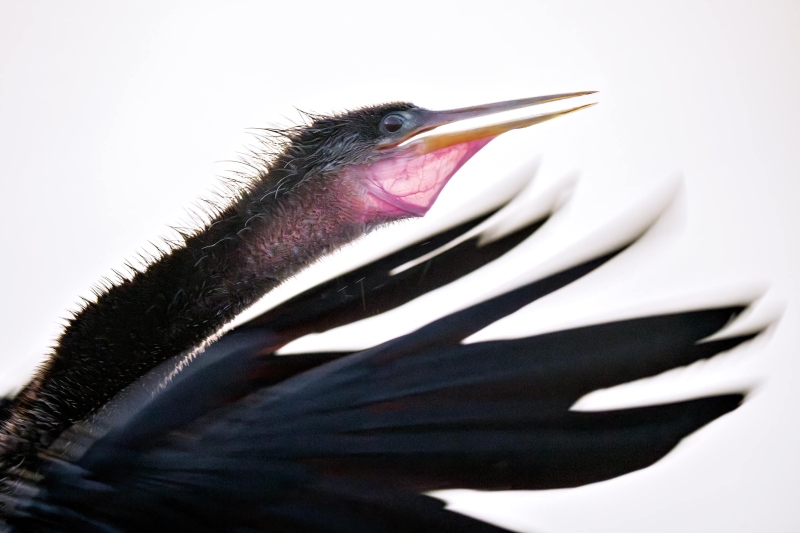
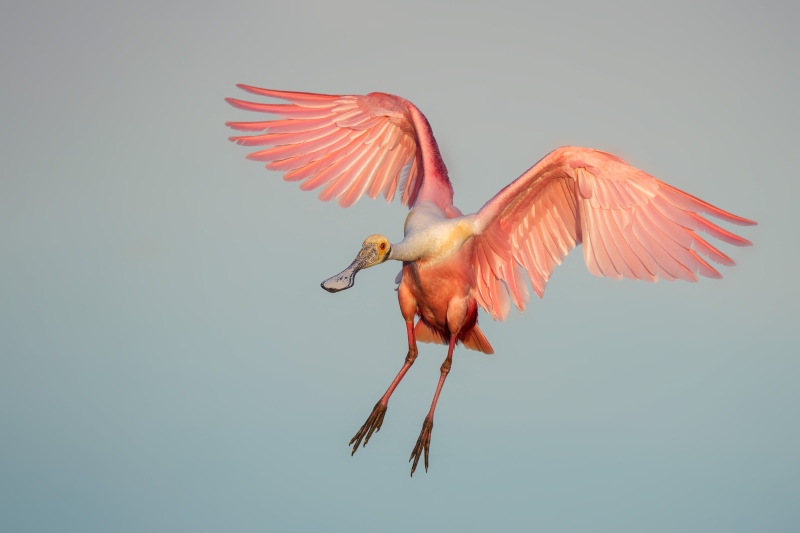
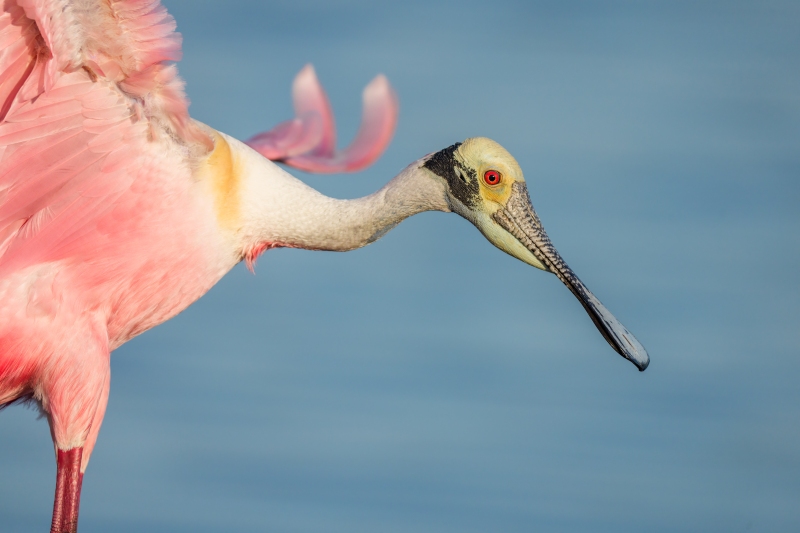
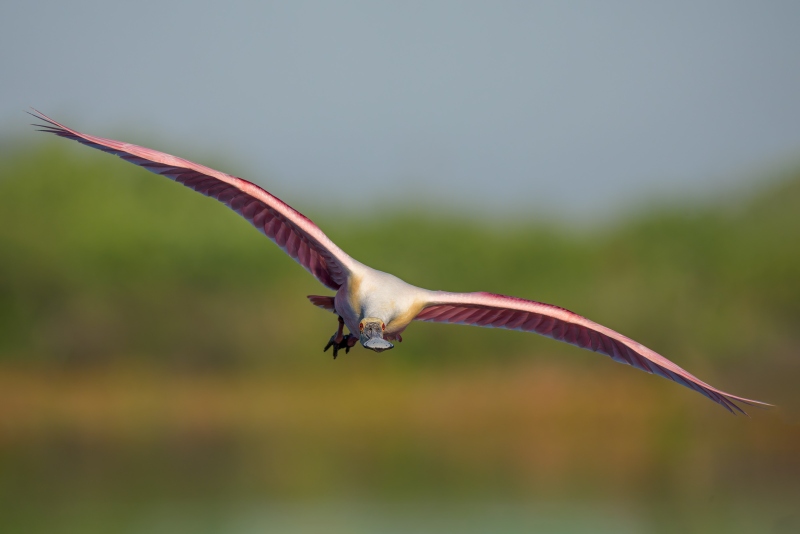

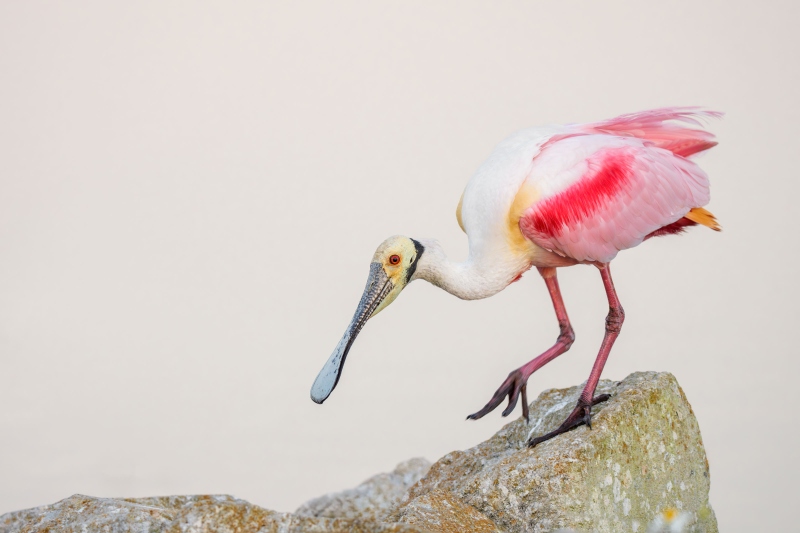
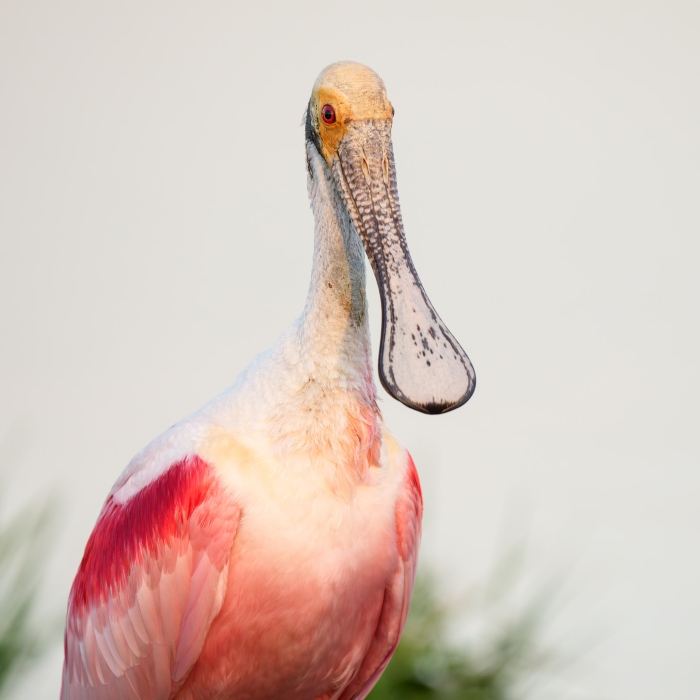









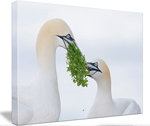



Jeez. I guess that my three favorites are the Anhinga, #3, the flight head shot, and #5, the preening body shot.. #s 2, 4, and 6 are also pretty special as well. That leaves #7 as my least favorite and most ordinary, but still, a pretty nice photo.
Thanks and love to all who commented and the rest of the gang as well.
artie
But surely you’re a fan of roseate spoonbills! (I actually thought of you when I read the relevant sections of the book.)
Yes, a great fan of spoonbills. But not of James Bond in any form.
with love, artie
Hi Artie, #5 is spectacular. The position of the bird is not something you see a lot, so uncommon.
The bird looks beautiful .
The others are more commonly seen (not the Anhinga though).
Also I love straight on bird photos like #7 for the framing, but in #5 the bird is gorgeous.
I hope that makes sense.
Hi Kerry. Nice to see your comment. It has been a while since Nickerson Beach. I agree that #5 is special. Some of the other behaviors are commonly seen but rarely photographed as well (he said modestly). And #3, a flight head shot, is rarely seen and rarely executed so well.
with love, artie
Ooohh, I like that #6 for creativity and #7 for the long bill
Art: Some typos: (1) Under Your Call — Why you made (not mad) and (2) Under What’s Up — I continued to experiment (experimenting).
First choice: #2 traditional picture of spoonbill in flight and #6 (raised foot suggests action)
Thanks, Pat Typos fixed; good catches.
with love, artie
#1 is my choice for a great photograph. I wouldn’t hang it on my wall as it’s kind of an ugly bird (sorry bird). But the diagonal lines are spectacular. Like the blurred wing feathers. 20,000 ISO is miraculous !!!
Can’t choose between #5 and 6 for next choice. I like them for behavior. and of course the RS’s colors are so beautiful.
Thanks E+O.
with love, artie
This has nothing to do with photography, but while we’re on the subject of roseate spoonbills, these birds figure prominently in a book I just read: Ian Fleming’s 1958 James Bond novel, . .
Thanks. Never a fan of JB.
a